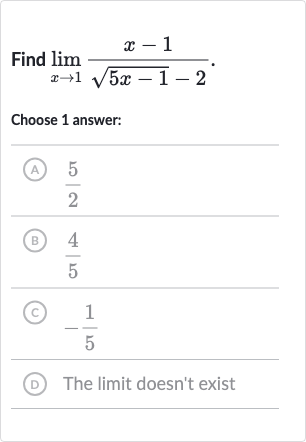Full solution
Q. Find .Choose answer:(A) (B) (C) (D) The limit doesn't exist
- Substitute : To find the limit of the given function as approaches , we first substitute into the function to see if it results in an indeterminate form.Since we get , which is an indeterminate form, we need to use algebraic manipulation to simplify the expression and resolve the indeterminate form.
- Multiply by conjugate: To eliminate the square root in the denominator, we can multiply the numerator and the denominator by the conjugate of the denominator. The conjugate of is .
- Simplify denominator: Now we simplify the denominator using the difference of squares formula: . The denominator becomes .
- Expand numerator: The numerator is expanded by distributing to both terms in the conjugate . The numerator becomes .
- Factor out common terms: Now we have the following limit: We can simplify this by factoring out common terms and canceling them out.
- Cancel out common factor: We notice that the numerator and denominator both have terms that can be factored by . The numerator can be rewritten as and the denominator as . Now we have:
- Simplify expression: Since is a common factor in both the numerator and the denominator, we can cancel it out, leaving us with:
- Substitute : Now we can substitute into the simplified expression without getting an indeterminate form:
- Final result: The limit as approaches of the given function is , which corresponds to answer choice (B).

